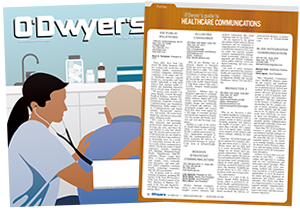 Michael Roth & Liz DeForest authored this piece. |
Hospitals are becoming payers. They are starting venture capital funds and incubating health tech startups, monetizing innovations and creating new revenue streams. Care protocols and drug, device and service choices historically made by clinicians are increasingly made by “value analysis committees” whose decisions are implemented across integrated provider networks. And as providers collaborate more on care coordination and delivery, they’re looking for proof that their potential affiliates add value to new narrow networks. Those that don’t are excluded and face loss of market share.
These stem from reimbursement changes which are driven, in turn, by a combination of factors including: the Affordable Care Act, financial and clinical regulatory pressures, nonprofit/for-profit and domestic/global tax implications, global competition, new research and development funding sources, transparency and patient consumerism.
|
|
To prove our value, healthcare marketers must step back and recalibrate. We need to re-examine how new and existing stakeholders influence our clients’ futures, and direct resources toward reaching multiple audiences with messages that resonate in an era of value-based reimbursement.
What does “value” mean?
Healthcare marketers are deeply familiar with “the shift from volume to value,” in which health businesses that deliver more value get paid more, and those that deliver less get paid less … if at all. To best perform our role as marketers, we must understand value as a mathematical equation:
The kicker here is that outcomes measurement, as the industry knows, is ill-defined.
And that’s an opportunity. The value of healthcare marketers is increasingly our own ability to help define and articulate value to multiple new healthcare stakeholders.
As one example of interrelated value propositions, take Medicare reimbursements. The U.S. Department of Health and Human Services has committed to tying 90 percent of Medicare payments to value by 2018. In April, they launched the first mandatory bundled payment model, the Comprehensive Care for Joint Replacement Model. Under CJR, Medicare pays hospitals a fixed dollar amount for every hip and knee replacement surgery and all related care inside and outside the hospital for 90 days, including surgical services and materials, post-acute care, drugs, rehabilitation and any readmission. Care providers that can’t keep costs within that fixed amount must eat the difference. Those that can, keep the difference as a bonus.
Now, say your company makes joint implants or a suture alternative that promotes faster incision healing. Or your skilled nursing facility has the lowest joint replacement readmission rate in the area, plus you’re affiliated with a home health network that can provide rehabilitation at an even lower cost. How are you messaging the value you provide to the influencers scrutinizing every variable in an effort to stay as far under that CJR cap as possible? Can you articulate the reimbursement challenge as it relates to the person who decides whether to use your service or product — even if they haven’t yet identified it themselves — and can you explain how you fit into the solution?
If you’re not explaining yourself, rest assured that someone else is ready to speak up. New Medicare waivers create opportunities for home health agencies and telehealth entities to receive Medicare reimbursements that weren’t previously available to them.
That’s a lot of stakeholders and a lot of value propositions competing for a limited bundle of funds, and that’s just one reimbursement shift. We haven’t even touched on the audiences of for-profit nursing home investors or the private equity firms that are buying up and consolidating home health agencies.
From B2B and B2C to B2B2C2B2B …
In this rapidly-changing healthcare industry, audience segmentation and message development is never fully “done” because the forces bearing down on healthcare businesses, and businesses’ own transformations, demand a state of constant adaptation and change.
Healthcare marketing departments often have the most comprehensive picture of the organization and its myriad of stakeholders. As that picture grows more complex, it is our responsibility as strategic counselors to monitor changes to stakeholder pain points, articulate the messages that most resonate with them, and help our clients prioritize scarce resources to reach the audiences most critical to the organization’s goals.
Here’s where the rubber hits the road: healthcare marketers need to develop better understandings of the trends and stakeholders outside of clinicians and consumers, which for many have been their traditional areas of expertise.
Medicare’s CJR program is just the first mandatory bundle; what relationships will be impacted by the cardiac bundle models being iterated now? By the oncology bundles likely to come next?
How will a hospital system building a health technology incubator need to look at its audiences and the sequencing of its messages to reach investors, techies and clinical testing partners, and then to publicize those new technologies to both local consumers and with other care providers that might license them?
Health businesses desperately need healthcare marketers who understand how their companies make money now, how they won’t make money in the future, and how changing psychographic trends, regulatory and legislative initiatives and technological developments could impact new opportunities.
The healthcare marketers that are best able to prove their own value and ROI will work with their client organizations to prioritize customer and stakeholder segments and identify opinion leaders, forums, and messages that matter most to them. The result will be an interrelated, impactful, comprehensive stakeholder communications program tailor-made for the new health economy.
***
Michael Roth is Head of the Healthcare Practice at Bliss Integrated Communication. Liz DeForest is an Account Director at Bliss Integrated Communication.



 Lo Isidro, senior director at Real Chemistry with more than a decade of strategic communications and PA experience, has joined Narrative Strategies.
Lo Isidro, senior director at Real Chemistry with more than a decade of strategic communications and PA experience, has joined Narrative Strategies. Nelson Fernandez, former North American chair of APCO Worldwide and managing director of Burson-Marsteller, has joined Volunteers in Medicine Berkshires as director of communications and PA.
Nelson Fernandez, former North American chair of APCO Worldwide and managing director of Burson-Marsteller, has joined Volunteers in Medicine Berkshires as director of communications and PA. Lilit Bargar, who was most recently an EVP in the healthcare practice at Weber Shandwick, comes on board at GCI Health as EVP, corporate practice lead.
Lilit Bargar, who was most recently an EVP in the healthcare practice at Weber Shandwick, comes on board at GCI Health as EVP, corporate practice lead.
 Five ways that successful thought leaders are made.
Five ways that successful thought leaders are made.


 Have a comment? Send it to
Have a comment? Send it to 
No comments have been submitted for this story yet.